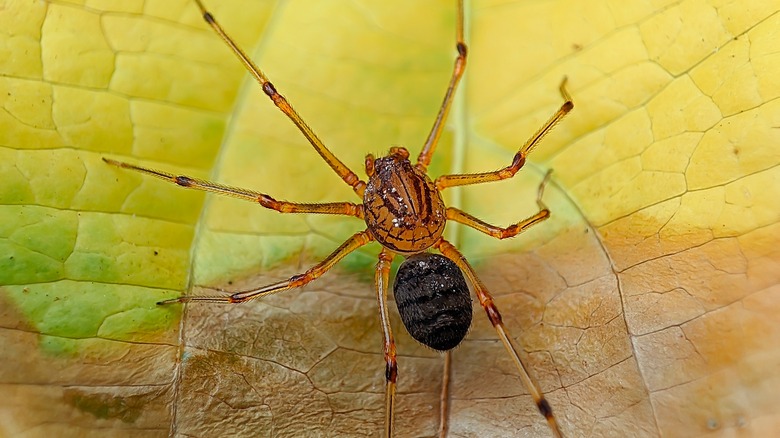The Scytodes Spider Uses A Fascinating Trick To Trap Its Prey
Spiders have all sorts of ingenious and often sneaky tactics to trap prey. So-called pirate spiders will, for example, tap on other spider webs to trick their owners into thinking they've caught prey, only to devour their fellow arachnids once they emerge. But even that isn't quite as devilishly impressive or upsetting as the various species of spitting spider, which project a sticky glue substance to immobilize prey (much like Spider-Man). Unlike the great Peter Parker, however, these spitting spiders also have a penchant for feasting upon the insides of their captured prey.
The family Scytodidae, otherwise known as spitting spiders, includes more than 200 species across four genera, and the Scytodes genera is the most well-known. The most widespread spider within the Scytodes genera is Scytodes thoracica, which looks like a brown recluse and is found in Europe, North Africa, Turkey, Iran, and parts of Asia. It has also been introduced to North America, Argentina, South Africa, India, Australia, and New Zealand.This tiny spider only reaches sizes of between 0.12 to 0.24 inches in length, but that doesn't quite convey its ruthlessness when it comes to trapping and eating prey.
Scytodes spiders have a domed cephalothorax (a conjoined head and thorax section), on which sit two glands capable of producing venom and glue. The spiders use these glands to spray a sticky fluid with alarming speed, trapping prey and making it much easier to devour. But that's not where the nightmare ends for those insects unlucky enough to become ensnared in Scytodes silk.
The Scytodes spider had a ruthlessly effective hunting method
While most spiders hunt solo, using webs and venomous fangs to trap and eat prey, Scytodes spiders take things a step further with their immobilizing projectile glue. It seems there's some debate about whether Scytodes spiders actually spit venom at their prey. While a 2009 study from the Journal of Insect Science describes the genera as spitting a mixture of silk, glue, and venom, a 2013 study published in the Journal of Proteome Research noted that this spit mixture actually has no toxic effects on prey, and that it serves as a way to immobilize prey before the spider can bite down and actually inject the venom.
Either way, it's a unique hunting tactic that gets more unpleasant the more it goes on. The spiders actually use their two front legs to tap around their victim prior to launching their lethal silk. This allows them to find the ideal position from which to spray, which they do by firing silk from alternating fangs, zigzagging the strands and forming a net that immobilizes the prey completely. The silk releases at an incredible speed of up to 30 metres per second and congeals once it hits its target, all of which happens in just 1/700th of a second.
Once a Scytodes spider captures prey, it will use its fangs to fill its victim with venom, further paralyzing it before a corrosive saliva liquefies the poor creature's innards. Why? Well, because it makes it easier for the predator spider to suck out the insides of its prey like some ghastly milkshake of insect viscera.
The cannibal Scytodes spider species
Since Scytodes spiders are a venomous species, should we humans worry about these tiny predators suddenly emerging from the darkness and firing their sinister silk at our eyeballs? No, not really. Scytodes spiders aren't considered dangerous to humans and mostly hunt under cover of darkness, otherwise preferring to stay out of sight. But somehow, that doesn't make them any less unpleasant to think about, especially when you consider there's a particular species of Singaporean Scytodes that delights in feasting on its own kind (though it certainly isn't the only spider species that has turned to cannibalism).
A 2009 study published in the Journal of Zoology described what seemed to be a new species of spitting spider, named Scytodes sp. by the authors. This species, previously identified as Scytodes pallida, was observed in the wild and in a lab setting. Researchers found that Scytodes sp. was "subsocial," in that it would cooperate with others of its kind, forming groups of four or more to trap flies, though that kind of behavior was typically only observed in young spiders. Still, it's remarkable for several reasons, the most notable being that only around 40 species of spider are considered social, and with 50,000 or so species of spider in the world, that makes these Singaporean arachnids a truly rare find.
Unfortunately, the spider's mercilessness doesn't just extend to flies and other insects. As noted by the researchers, Scytodes sp. youngsters were also observed feasting on one another, to the extent that fratricide was the biggest threat faced by these spiderlings as they grew older. According to the study, around a quarter of the spiderlings had been killed due to cannibalism after six weeks of life. Otherwise, this particularspecies of spitting spider was content to let the mother do all the hunting, remaining in its home web and waiting for insects to be delivered.


